Auden Johnson's Blog, page 3
April 16, 2021
Affordable Nature Landscape Photography Gear
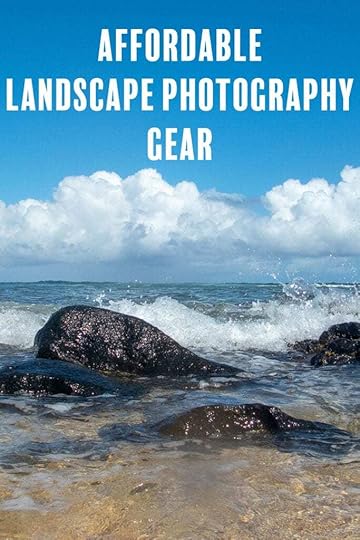
Nature landscape photography is an expensive hobby. Cameras, alone cost more than my rent. The lenses can run more expansive than the camera. I’ve read a lot of articles and watched many tutorials. The experts keep recommending equipment that’s way out of my price range. They’re probably the best equipment but I’m not going homeless just so I can get top-tier equipment.
So what do you do if you want to get into photography but can’t afford high-end equipment?
Having jumped from minimum wage job to minimum wage job, I’ve had to master the art of photography while broke.
Don’t buy everything at onceFigure out what you need right now. I’ve been doing photography for a little over 5 years now and I only recently bought a tripod. I’ll talk more about this later, but you can get around not having a tripod. Certain things like a wide-angle lens can make your photography better but you can take good photos with a simple 58mm lens.
CameraI have a Canon EOS T5i Rebel. Bought it from Best Buy mostly because I’m familiar with Canon and that was the cheapest DSLR they had. The package came with the camera body, one 18-58 mm lens, an over-the-shoulder camera bag and an SD card. All that cost about $800. Not cheap but affordable compared to most DSLRs.
I’ve taken this camera hiking through the mountains, to the ocean, through NY snowstorms and it’s still kicking. Being an entry-level camera, it has limitations. I plan on upgrading when I have the funds. But, so far, it does what I want.
One of my favorite shots wasn’t actually taken with a DSLR.
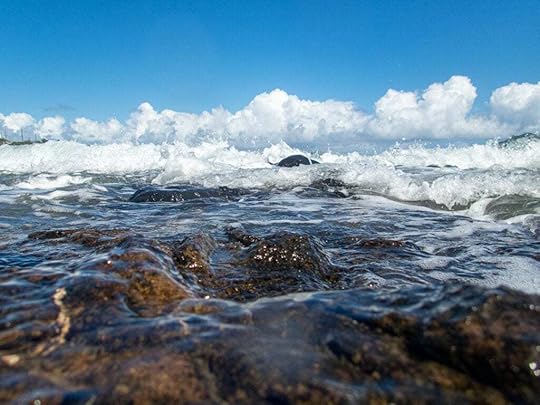 4.5 mm, 1/25 sec, F/8, ISO 100
4.5 mm, 1/25 sec, F/8, ISO 100I had rented a waterproof camera because I wanted to try underwater photography. If you can’t afford a DSLR, you can find a point-and-shoot camera that takes beautiful photos. I shot the above photo with the Olympus Tough TG-5. It costs about $500
TripodAs I mentioned, I didn’t have a tripod until last year. It makes nature landscape photography so much easier but you can get around with not having it. I took the below photo but sitting on the ground while steadying the camera on my knees.
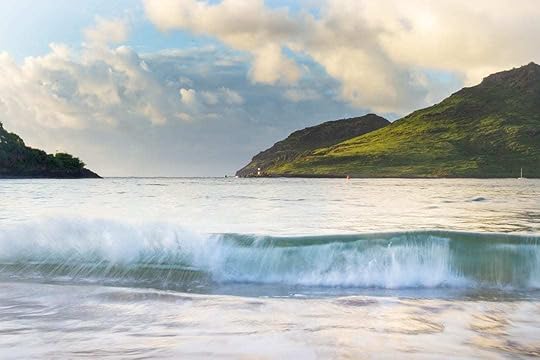 35 mm, 1/10 sec, F/29, ISO 100
35 mm, 1/10 sec, F/29, ISO 100I’ve propped my camera on rocks, fences, against trees, on tables. Being broke forces you to get creative. If you can’t affordd a tripod, there are ways around that.
Tripod can cost as much as $100 or more. Obviously, I didn’t spend that much on mine. I bought the UBeesize 60-inch Camera Tripod for $30. I haven’t seen a need to upgrade. It does what I want. The tripod can take a beating. When hiking, I’ve used it as a trekking pole when I’m tired. I strap it to the bottom of my hiking bag where the sleeping bag usually goes. Often, when I’m tired, I just drop my bag on the ground. So far, my tripod hasn’t broken from the impact. It’s pretty light so it doesn’t make my bag too heavy.
LensI haven’t yet found an affordable wide-angle lens. If you know of one that doesn’t cost a couple thousand dollars, please comment below. I did find a good telephoto lens that only cost me $200. I bought the Canon EF 75-300mm f/4-5.6 III Telephoto Lens because I wanted to shoot the moon. Although I can’t zoom in as close to the moon as I’d like, the lens does the job.
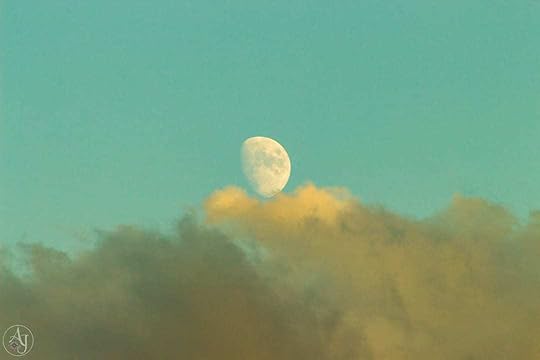 300 mm, 1/500 sec, F/10, ISO 250
300 mm, 1/500 sec, F/10, ISO 250A telephoto lens does make it easier to get those nice macros or animal shots but, I took the below photo with my regular kit lens. I just had to get super close.
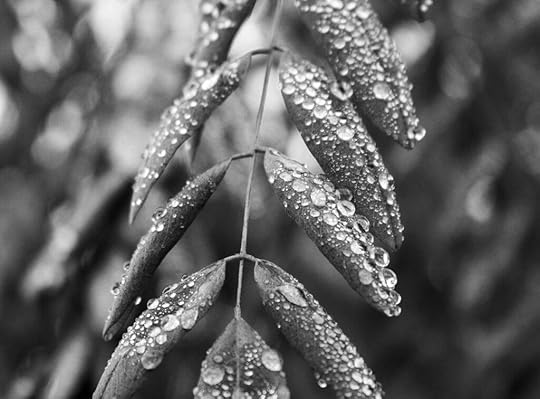 51 mm, 1/80 sec, F/5.6, ISO 320ND Filters
51 mm, 1/80 sec, F/5.6, ISO 320ND FiltersI bought ND Filters because my hiking trip had me photographing in the middle of the day, I also wanted to do more long exposure photography. I talked about that in the post Hiking Adventures: Capturing Beautiful Fall Landscape Photos. Filters are also good for properly exposing the landscape and the sky. Sometimes, when you’re photographing, the landscape will be properly exposed while the sky is blown out. Like with the tripod, I bought ND Filters only last year. You can fix exposure in post. Shoot the photo in RAW and expose for the sky. The land will come out too dark but you can fix that in Lightroom or whatever editing software you use. The Rangers 8pcs ND Filter kit is only $30.
Having a thousand-dollar DSLR and the best equipment may help you take better photos. But, you don’t have to spend a bunch of money to get some beautiful landscape photos.
April 12, 2021
Should Authors Read Their Book Reviews?
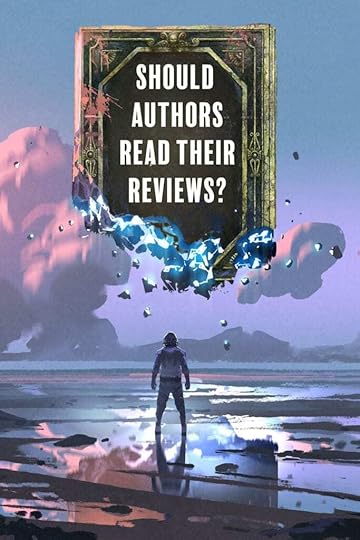
Whether or not authors should read their own book reviews has been a topic written about a lot. Some people say yes. Most people say no. Honestly, it’s up to you. I used to read my own reviews. But, the negative ones had a bad impact on my mental health. I never got used to it or learned how to deal with it. Now, I read reviews people post on their blogs, most of the time. They’re a good place to get quotes to put in your description. For sites like Goodreads, Amazon or Barnes and Noble, I’ll look at the overall star rating but I never read those reviews.
Here are a few things to keep in mind if you’re on the fence about reading your book’s reviews.
Book Reviews Aren’t for UsYears ago, when I was thinking about whether or not I should continue reading my own reviews, I come across a post that said book reviews are for readers, not authors. The reviewers are readers telling other readers what they liked and didn’t like about the book. Because of social media, if someone wants to contact me, personally, about their opinion of my book, they can DM me or email me. This convinced me that I don’t need to read my reviews.
Decide If You’re Someone who Can Handle Bad ReviewsI am not in a good place where I can handle bad reviews. That’s fine. Be honest with yourself. Are you someone who can handle a ton of bad reviews? You will get them. You may even get a lot of them one right after the other. That doesn’t necessarily mean your book is bad. My books are dark. They tend to have a lot of gore in them. Unfortunately, they sometimes fell into the hands of people who didn’t like that.
Don’t Look for Validation in Book ReviewsLike most people, this past year has done a number on my mental health. For me, things have been pretty bad since 2016. Obviously, nothing is all good or all bad. Some good things happened but overall the past 5 years have not been great. I’m slowly trying to figure out how to fix that.
Temporarily, I’ve stopped looking at website analytics, Instagram post likes and social media followers. I’m generally avoiding my Instagram and Twitter Profile pages, sticking to the Home and Explore feeds. Why? Because I realized I was looking for validation through those analytics and I’d get depressed and frustrated when I wasn’t getting it.
I like being active on social media. I enjoy sharing nerdy stuff. Even before the rona, I didn’t have a lot of nerdy people around me. It’s fun to have a space where I can talk about anime and video games, to talk about photography/hiking stuff and what I’m learning about both. I’m trying to get back to that.
I would suggest, in general, don’t look to outside input for validation. It’ll only depress you when you don’t get it.
Taking the TemperatureThis author gave a valid point about why she reads her own book reviews.
Mostly, she reads them to gauge how her books doing. But, she reaches a point where she’ll stop.
Looking For Feedback from ReviewsI’ve read a lot of comments from authors who got good feedback from their negative reviews, comments that helped them improve their next books. That’s the reason I had started reading my book reviews in the beginning, But, in my case, the bad reviews were from people who’d never enjoy my books. I published my first book in 2014. Since then, I’ve never received a helpful negative review. I get my best feedback from beta readers.
By the time your book is released, it should’ve gone through editors and beta readers. That is where you should be honing your skills, learning what does and doesn’t work in your story. Some things will slip through the cracks. People aren’t perfect. But, as I mentioned before, reviews aren’t for you. It’s a bit too late to learn about a major flaw in your book through reviews.
Should you read your own reviews? It’s up to you. Sit back and think about why you’re reading them. If you’re looking for validation, what’s going on happens when you get a series of bad reviews? You can’t control how people receive your book. However, good or bad, you should never comment on a review.
The one thing an author should never, ever do.
April 9, 2021
Creating Fantasy Landscapes with Infrared Photography
I enjoy photos that look like they were taken on an epic fantasy quest. Hiking is kinda like a fantasy adventure only your reward isn’t a world-saving talisman but a spectacular view and improved mental health. Infrared photography seems right up my alley. This photo looks otherworldly.

I haven’t started taking real infrared photography since I don’t have all the equipment yet. Mostly, I’ve been having fun creating the false-color infrared effect in Photoshop. It’s good practice to see what kind of scenes and compositions work best for infrared.
I learned how to do that effect from a post on Digital Photography School. If video works best for you, watch this tutorial.
While I prepare to take otherworldly landscape photography, I’ve been doing some research. I also search Behance and Pinterest for photo examples.
Here are a few things to keep in mind if you want to get into infrared photography.
Test Your CameraBefore you buy any equipment, you need to make sure your camera can shoot infrared photos. Take a regular TV remote control and point the sensor at your camera. Look at the remote through your camera’s LCD screen, not the viewfinder. Push any button on the remote. If you see a white light, you can take infrared photos. If your camera doesn’t have a Live View setting, take a photo of your remote with any button pressed and look at the shot.
It’s still up in the air if my Canon Rebel T5i can take infrared photos. My remote light come out purple. We’ll see.
Buy an Infrared FilterIt seems the cheapest way to do infrared photography is to buy a screw-on lens filter. Most articles I read recommend the Hoya R72 Infrared Filter. It’s not cheap though but photography is an expensive hobby. It’ll cost about $50. Since I’m not sure my camera can do infrared photos, I ordered cheaper filters from Amazon. I haven’t yet tried the Neewer 4 Pieces 58MM Infrared X-Ray IR Filter Set but from the reviews, they seem to be good entry-level filters.
Sit Your Camera on Something Sturdy when Taking Infrared PhotosThe infrared filter, apparently, darkens your scene. In order to get a perfectly exposed shot, you need to use a slow shutter speed. You can’t hold your camera while taking infrared photos. The shot won’t come out sharp. You need a tripod.
Or, you need to set your camera on something solid, like a rock or fence. I didn’t own a tripod until recently. If I wanted to do long exposure photography, I’d rest my camera on my knees if I had to. I may to a separate blog post about broke photography.
Summer is the Best Time to ShootSpring and Summer, particularly, summer, are the best seasons for capturing landscapes in infrared. This is a good time to start a new photography hobby.
 Time for Midday Photos to Shine
Time for Midday Photos to ShineMonths ago, I was working to level up my photography skills. All the videos said to avoid shooting during midday. The harsh sunlight overexposes your photos while making the shadow too dark. However, I could only hike during midday because I didn’t want to be on the trail when it’s dark.
I was stuck. How could I take nice photos if I could only shoot during midday? Turns out, infrared landscape photography works best when shot under that harsh midday summer sun.
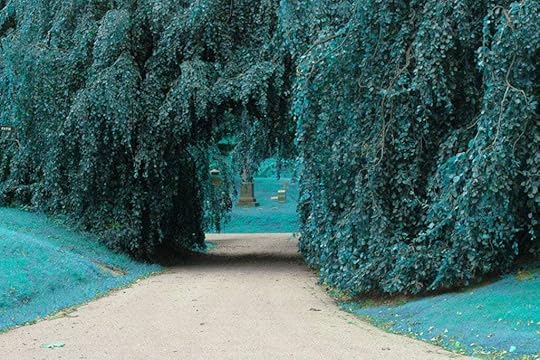
It’s funny. Because of my WIP Book 4 of The Merging Worlds series, I’ve become a bit obsessed with unusually colored, glowing plants and animals. These photos may give me some landscape inspiration.
This year has already been a mental health struggle. Just getting out of bed is a fight. It’s nice to have a project to dig into. If you’ve been struggling, think of something you can throw yourself into. I’ve been gaming a lot, like a lot. I also got back knitting and I started making hemp bracelets. Infrared photography will provide another welcome boost. I’m still doing research. When I learn something new, I’ll share it with you. It’s been fun creating the infrared effect in Photoshop and experimenting with different colors. Check out my Behance page for more photos.
If you have any infrared photography tips to add, comment below. I’d appreciate the help.
More ResourcesHow to do Surreal Digital Infrared Photography Without Expensive Gear or Camera Conversions
March 19, 2021
What to Pack in Your Day Hiking Bag?
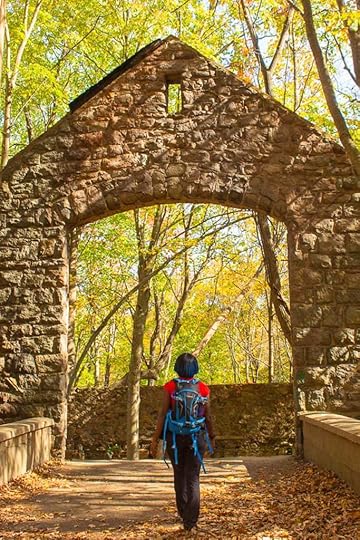
The weather’s getting nice. It may be time to pack that hiking bag and take a day trip. Hiking is fun, most of the time. But it’s not about just grabbing a bag and going on a walk in the middle of nowhere for several hours. You have to prepare, especially if you’re going alone. I solo hike mostly because I don’t know anyone who’d want to walk up a mountain for several hours.
What’s in my hiking bag?
The BagI spent weeks searching for an affordable camera hiking bag only to give up. The ones in my budget were only large enough for camera equipment and nothing else. No room for food, water or emergency supplies. If I went large, the price jumped to well over $100. I settled for the TOMSHOO 20L/30L Backpack. Then I bought a DSLR case that protects my camera even during a snowstorm. I talked about that in the post Winter Landscape Photography Tips for Capturing Snow.
I also carry cushioned lens pouches that hook onto the front of my bag. I really appreciate the cases when I’m taking a break after several miles. I’m tired and just drop my bag on the hard ground, completely forgetting my lens is attached to it. My tripod is strapped to the bottom where the sleeping bag would be.
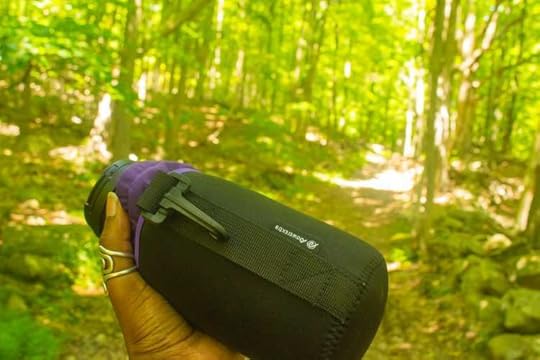
I started with a 40 L bag because I didn’t think 20/30 L would be large enough for all my camera equipment. My stuff fits in the smaller one but it can be a pain to get them in and out of my bag. I don’t use the 40 L bag as much but I loved it. The bag looks big but it wasn’t that heavy.
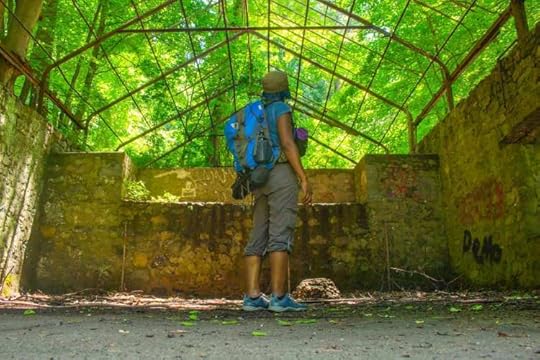 For Emergencies
For EmergenciesIf you’re a person who likes jewelry, you may have a collection of drawstring cloth bags of various sizes. I grabbed a larger one and stuffed it with bandages, gauze, alcohol swabs, painkillers, an emergency blanket and other first aid supplies. That just stays in my bag. I’ll take it out every now and then to check it and swap out certain things. An emergency blanket is important. You may plan to be out of the woods by dark but if something unexpected happens, an emergency blanket makes a good shelter. On that note, I also carry a jacket in my bag, even in the summer. As well as a headlamp. I bought one from my local pharmacy. It’s not a dedicated hiking lamp but it does the job.
Food and WaterIt’s cheaper to make your own trail mix. I’ll buy a large bag of grain (or birdseed as I call it), like Bear Naked Granola. It’s pretty good. It just reminds me of bird seeds. While searching for hiking food, I came across candied walnut recipes. They are now my new favorite hiking snack. One weekend, I’ll make a large batch of candied walnuts. For my hiking trips, I’ll throw a handful of them in a baggie with some granola and candy. I’ll sprinkle in some caramel apple chips I get from my local grocery store. I love these things.
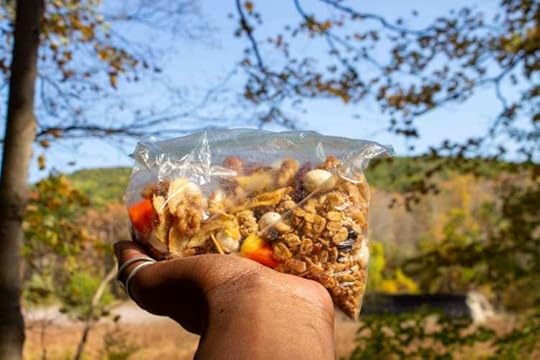
For water, I carry a 750ml bottle. In the summer, I’ll bring two. When it’s hot out, I go through water far faster than expected. I really don’t want to buy water while I’m out. They cost way too much. Eventually, I’ll be adding a bladder to my hiking bag. Sounds weird. But anyway, carrying that will probably be better than two water bottles.
I’ll also pack a separate baggie of dried fruit, usually pineapples and mangos. For some reason, I don’t get that hungry on the trail. I used to pack sandwiches but stopped when I realized I wasn’t eating them.
Extra EssentialsI recently added Covacure Trekking Poles to the mix. They’re pretty new so I’ve only used them once but, they came in handy. I also want to learn how to navigate using only a map and compass. So, those are always in my bag. I bought a simple compass to practice. I’ll probably upgrade when I get the hang of it.
Getting the map was an adventure. I thought I could just buy it on Amazon but I had to go directly to the source to get the latest version. Keep that in mind when you buy your map. Make sure it’s the latest version. I also carry a case of ND Filters. I don’t use them that often but I’ve found that I usually need them when I don’t pack them. So, they stay in the bag.
Since I’m a writer, I never go anywhere without a journal and a couple of pens. I bring my tablet to read on the two-and-a-half-hour train ride to and from the trail.
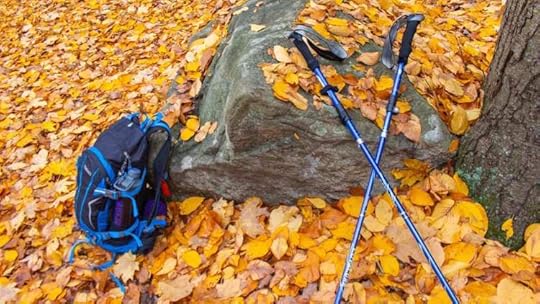
What’s in your hiking bag?
March 15, 2021
Fantasy MapMaking Software for Authors
I mentioned in the last post 2 Ways to Make Fantasy Maps in Photoshop, that I, as the title says, use Photoshop to make my fantasy maps. But, I am curious if there’s an easier way. I like Photoshop but is there a better fantasy mapmaking software out there?
InkarnateI made this with the free version.
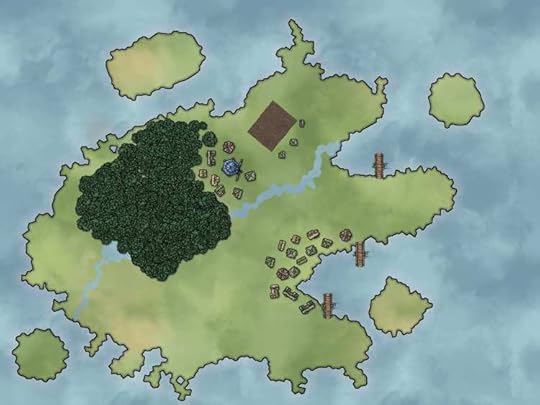
I like the default colors and textures. Also, like that way they do for the coastline. I wish the shape wasn’t as round but I still like how this turned out. Obviously, with the free version, you’re limited to what you can do. Doesn’t look like I can add mountains. The price isn’t that bad though. $5 a month. Not bad at all.
Since I can export the basic version, I could open it in Photoshop and finished editing. Kinda defeats the purpose but I really like those colors and how easy it to make a landmass and doing so would make things a bit easier.
WonderdraftI couldn’t experiment with this because you have to pay to download it. But, I’ve been hearing good things about Wonderdraft and the maps people create using it are pretty. It’s a one-time price of $29.99. That’s not bad.
WatabouThis one is pretty cool if you want a simple top-down city map. I don’t know if I’ll use this kind of map in a book but I love how it looks. I might figure out a way.

This mapmaking software didn’t require any payments to create this.
In my search, I came across World Anvil. It doesn’t look to be a fantasy mapmaking software but it seems to be a way to organize your world and create a kind of pretty wiki. Seems to be an interesting way of marketing a fantasy book. Looks like with World Anvil, you can make an existing map interactive. I may have to check that out. The site seems a bit like using Photoshop, you need a tutorial to understand it. I tried just diving in and got lost.
Because I use Photoshop to create book covers and other book images, not just maps, I doubt I’ll be replacing it with any of these apps. Inkarnate would be a good add-on, though.
Do you have a fantasy mapmaking app you’d like to add? Comment below.
March 7, 2021
2 Ways to Make Fantasy Maps in Photoshop
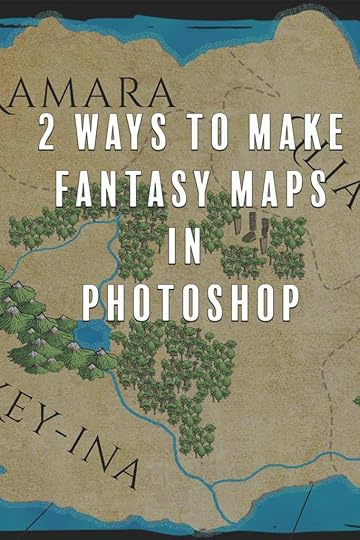
I got into making fantasy maps because I needed them for my books but, I couldn’t afford to hire a designer. That’s kinda been the case for most of my self-publishing journey. I would never tell any author not to design your own cover or never format your own books. Make sure you have someone or a group of people who will give you honest feedback.
Some of us just aren’t in the position financially to spent $1,000+ on a freelancer, no matter how good. I published my first book in 2014 and in 7 years, I’ve never been able to do that.
Fantasy maps, like book covers, aren’t easy to make and they require a lot of research. But, you can create a simple map with the right brushes in Photoshop or with stock images.
I wouldn’t consider myself a drawer. You’ll see in the first video, that I do a bit of drawing but for mountains and forests, I rely on brush sets I find on DeviantArt. I also don’t have a background in design. Everything you see, I taught myself.
Before you begin, research how things like rivers and mountains are formed. I still struggle with this.
Yes, you’re making a fantasy world but nature has an order to things. If you want to break that rules you need to know the rules. For instance, in my Merging World Series, Jael has a stretch of desert called the Alderic Abyss. The air is toxic for reasons no one can explain. This desert is also pressed up again snow-covered mountains. This does not happen in reality. However, there’s a magical reason why characters can see a snow-capped mountain from the desert.
Before you open Photoshop, draw a rough sketch of your map. It doesn’t have to be pretty. It doesn’t even need to be precise. I draw a general idea of my landmass or town. That gives me room to get a little creative when designing. This sketch will be your guide.
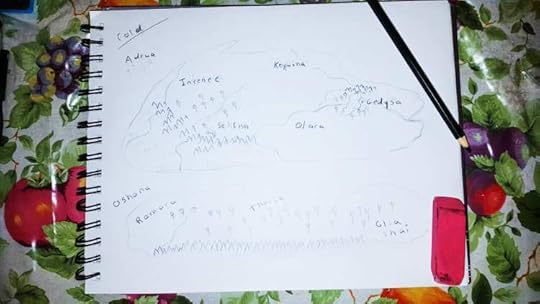 Fantasy Maps Method #1
Fantasy Maps Method #1The first map is based on what I learned from this tutorial series.
After I got the basics down, I looked at other maps on Pinterest and add my own style.
For instance, I noticed certain maps had a light gradient around the edges as a shoreline. I created mine using the Outer Glow Layer Style-Blend Mode: Dissolve. Experiment with the blue gradients to see which one works for you.
I made the map in the video using a brush set I downloaded from DeviantArt. The land texture is a simple parchment image turned into a Pattern. You can find free royalty-free parchment backgrounds from sites like Pixabay.
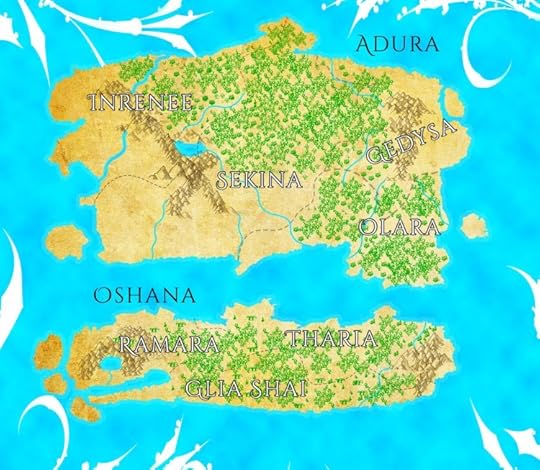
Here’s the color scheme I used for the map.

You can find it on Adobe Color.
To make the ocean I used the blues, one as your foreground color and the other as background. Doesn’t matter which, as long you have two different colors for your foreground and background. I created a new layer. Then, selected Filter-Render-Clouds.
Method #2: Stock ImagesThis was probably the fastest way to create a fantasy map. Still time-consuming. As you see from the video, I created a map using only stock images.
You can find map elements like the mountains and trees here. Stock photo sites also have map templates like the one you see at the beginning of the video. I used this one. Those images weren’t free. I have a monthly subscription to Shutterstock.
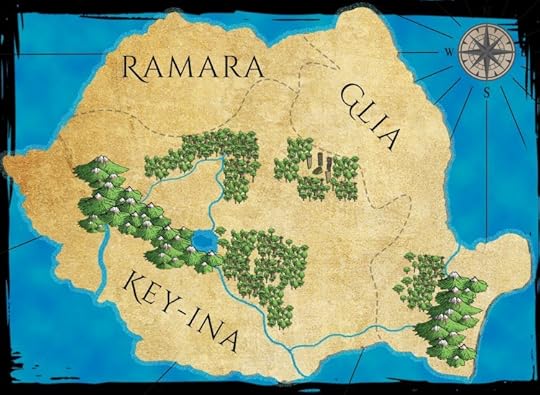
Don’t get discouraged if you can’t make maps like the ones you see in traditionally published books. As long as yours tells the story of your world, it works. Nothing wrong with a simple map. I’ve seen many highly reviewed and recommended indie books with fairly basic maps.
Do you have any questions? Comment below.
March 1, 2021
Writing Epic Dark Fantasy Books (Big Cast in Big Worlds)
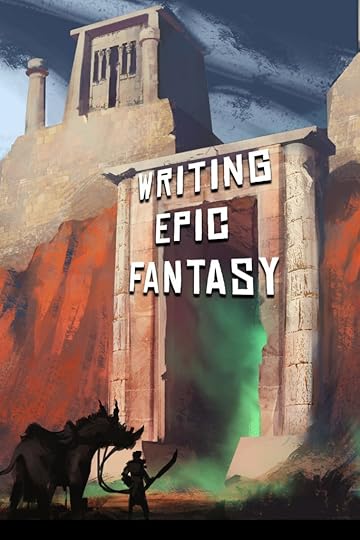
I’ve learned to never say I won’t write something. I used to say I’ll never write romance. Now, most of my books have a romantic subplot. I didn’t used to be a fan of epic fantasy. Now, I’m writing an epic dark fantasy series. Didn’t plan on it. My Merging Worlds series kept growing. Now, in book 4, the cast is large and the characters are traveling to different overseas lands.
But, this presents a bit of problem.
Let’s go back to the story of Book 4 and how it came about. My Merging Worlds series started out as standalone books. I had no intention of ever writing a series. One day, I realized that these standalone stories all happen in the same world.
Book 4 began as a short story that took place in a world where Darkness and Silence are alive. People need light or sound all the time or they’d get attacked. I did not want to turn that story into a novel because I knew the world-building would be a nightmare.
A big cast going on a dark adventure in a big fantasy world. How can one author manage that?
PlanI can hear all the pansters groaning. I’m a panster. I don’t do outlines. I don’t do in-depth planning. But, if you’re writing an epic dark fantasy story, you need to do some kind of planning.
What kind of planning depends on you. I’m mapping out time passing for each character, their travel itinerary and general arc for major characters.
Use a Note App Like EvernoteI’ve been using Evernote for years. It’s free. I can use it on the Desktop or phone. And, it lets me save any articles I find while researching. That’s particularly useful for this story. The characters don’t see a lot of sunlight and I need to research the effects of that.
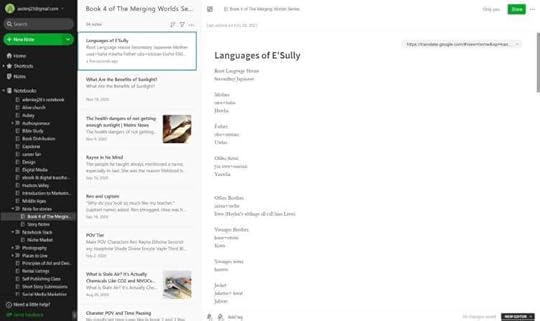 Create a Map
Create a Map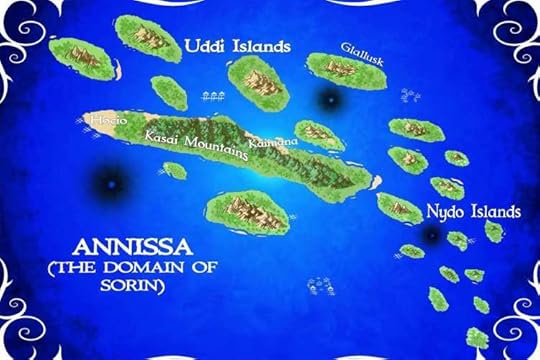
Also part of the planning but deserves a separate section. This helps immensely, even if you’re doing just a rough sketch. When you have a lot of locations, it’s hard to keep them straight in your head. I’d also suggest, if your story spans several landmasses, to do a world map.
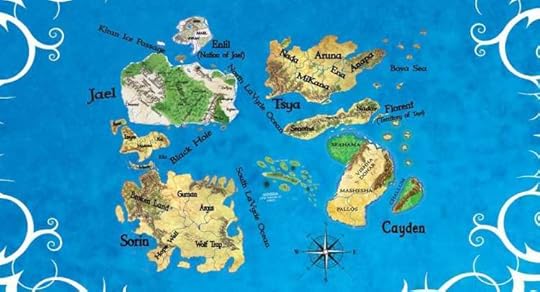
Also, write down how long it would take to get from one location to another.
Keep in mind, everyone in the world won’t speak the same language. You don’t have to create a new language but you might want to mention it.
One thing I’ve learned about world maps is that the landmasses should all be able to fit together. Kinda like Pangea.
 Write in Pieces
Write in PiecesSpeaking of languages, in my WIP The Sciell ‘s Legacy, I’m not bothering with that too much in the first draft. I’ll develop it more in the second and third drafts.
I’m also not writing this story linearly as I’ve done with other books. One day, I might work on the Divine’s chapters. Another day, I could be developing Ren’s adventure. Some days, I’ll only work on describing a setting. I am not editing as I go. I’m mostly writing the chapters and scenes out of order.
Be Able to Reorder ChaptersI write in MS Word. While working on The Sciell’s Legacy, I discovered that if I turn the Chapter titles into a Heading Style, I can move sections around.
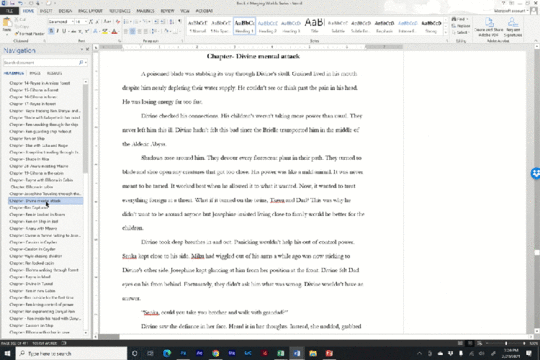
I love that I can do this. I write however I want then easily move the chapter to later or earlier in the story.
The Heading Style also makes it easier to navigate through my story. These chapter names aren’t going in the final version of my story. They make it easier to determine which chapter covers what since I’m writing out of order.
Choose a Few POV CharactersMy cast is fairly large.

All these people do not get POV chapters. The story mostly focuses on three- Rayne, Elihona and Ren. Rayne and Elihona are traveling together and Ren has his own adventure.
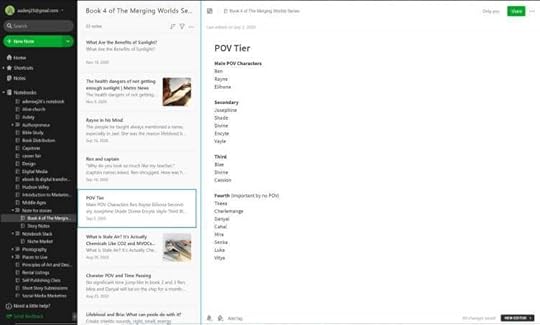
I treat all the other characters as an intermission. When I’m switching from the Rayne/Elihona story to Ren’s, I’ll insert a Divine POV, for example. It’ll be two chapters from Elihona’s POV, 2 from Rayne, 1 from Divine then 3 from Ren.
Be Careful with Character NamesWhen researching on writing a large cast, I learned we shouldn’t give characters similar sounding names or ones that begin with the same letter.
But, I broke that rule. There’s Ren and Rayne. Then we have Bley, Blae and Bel. Their names are important to the plot so I can’t change them. For Bley, Blae and Bel, I try not to put their names beside each other. Same with Ren and Rayne.
On top of that, certain characters have two Mom and Dads- their birth parents and the marriage Mom and Dad. For those sections, I’m rely on context clues to tell which Mom and Dad they’re referring to.
I’ll mostly have to rely on editors and beta readers to tell whether or not I managed it right.
Use a Character PlannerI’ve started using Character Story Planner and I love it. I think it’s only available for Android devices, though. This app lets you go deep into character planning. Helps a lot when you don’t remember character appearances. It’s good when you get some inspiration on-the-go, which has happened to me.
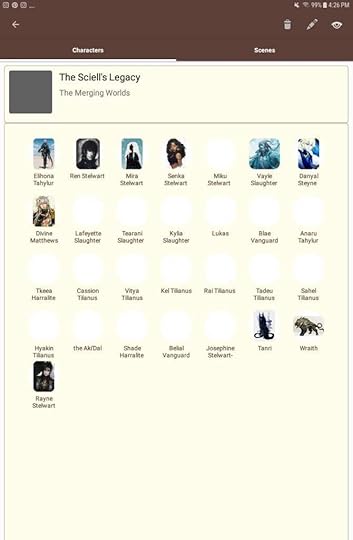
In addition, I listed all my characters in Word, giving them a brief description. Years ago, another writer mentioned also including a character’s soul wound- an internal darkness they’re dealing with in the story. I loved the idea.
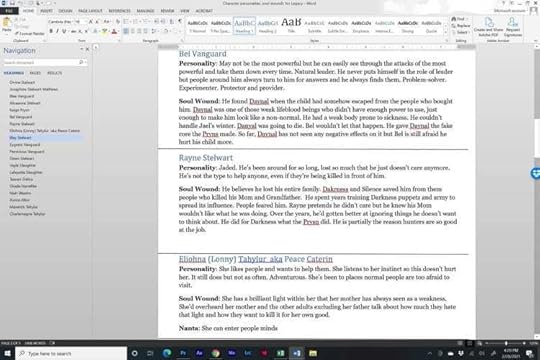 Be Ruthless When Editing
Be Ruthless When EditingOne thing I don’t like about some epic fantasy stories is that they’re long because they spend so much time on stuff that could be explained through dialogue or left out altogether. One book I started years ago had an interesting premise but it began with a chapter long exposition dump and I was not interested.
Epic dark fantasy books tend to be long. Book 3 of my Merging Worlds Series is about 150,000 words. Once I reached the final draft of Book 3: The Lost Sciell, I went through that book and deleted everything I didn’t think needed to be in there. I removed dialogue I enjoyed. Deleted entire chapters. If it didn’t move the story forward or made the story unnecessarily complicated, it got axed. Since I have so many characters, I removed the side ones that did little for the story.
Doesn’t matter how important you think the information is, if it doesn’t move the story forward, remove it.
You don’t have to delete those sections completely. I removed them from the story and put them in a deleted scenes document.
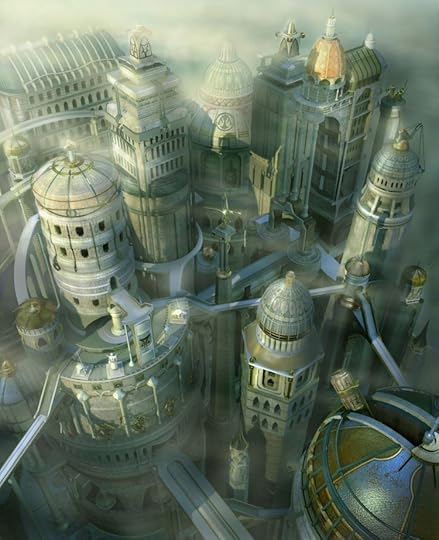
When writing an epic dark fantasy novel, planning is key. You have a lot of moving pieces. It’s difficult to keep everything straight. Find a way that works best for you. In the beginning, I printed all my notes and put them on a corkboard in my writing area. I bought a large poster board and drew my map on it and hung it on my wall.
More ResourcesFebruary 26, 2021
Capturing Beautiful Nature Photos at Boring Locations
If you’ve been on Instagram long enough, you’ve probably come across more than a few beautiful nature photos. I get a little jealous, wishing I could visit those places and capture scenes like that. But, even without the world falling apart, I don’t have the means to travel to those kinds of locations for photography. I shot the beauty of Hudson Valley, NY when I went hiking. And, I was fortunate enough to spend a week in Hawaii.
But, for the past couple of months, I’ve been limited to photographing my neighborhood and local park. They’re both nice but it gets old fast. On top of that, winter landscape without snow is kinda boring. Nature is mostly brown and bare.
How can you take beautiful nature photos of an uninspiring landscape?
I have an entry-level DSLR, the Canon Rebel T5i, as well as a fairly entry-level telephoto lens. Eventually, I plan to upgrade but right now, this equipment does the job.
Leave Early or LateA beautiful sunrise or sunset can transform even the most boring landscape.
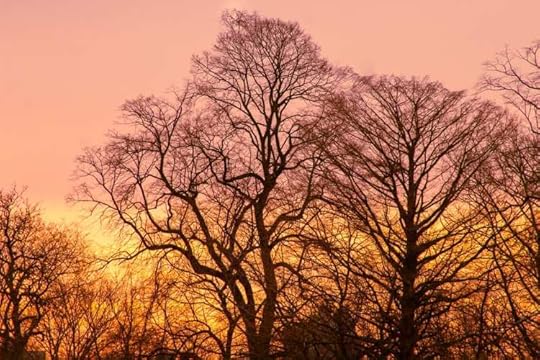 300 mm, 1/400 sec, f/10, ISO 1250
300 mm, 1/400 sec, f/10, ISO 1250Sunrise even makes winter look like autumn.
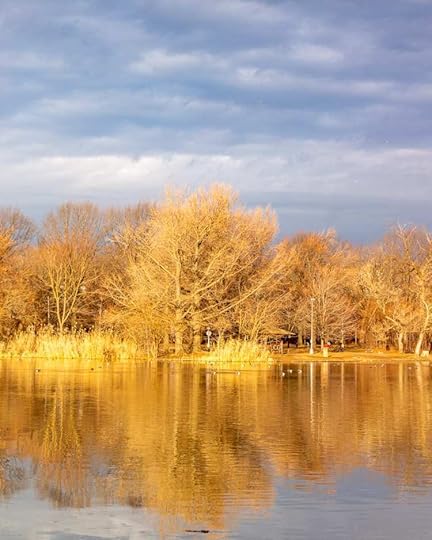 37 mm, 1/60 sec, f/10, ISO 100
37 mm, 1/60 sec, f/10, ISO 100The trees aren’t usually that color. Sunrise turned them that nice golden shade.
Same with this one.
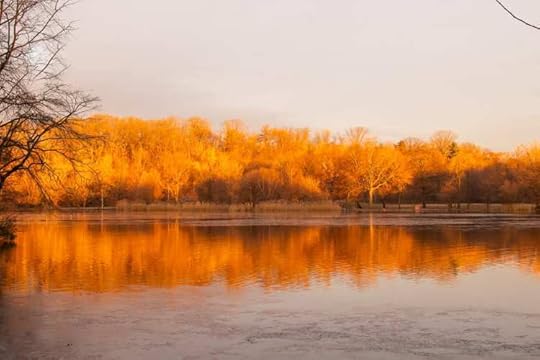 33 mm, 1/50 sec, f/10, ISO 1000Take Macros
33 mm, 1/50 sec, f/10, ISO 1000Take MacrosYou may have woken up to frost on the ground. Get up close to and photograph those pretty crystals. This is a good time to experiment. I’ve never even paid much attention to frost on the ground until I ran out of things to photograph.
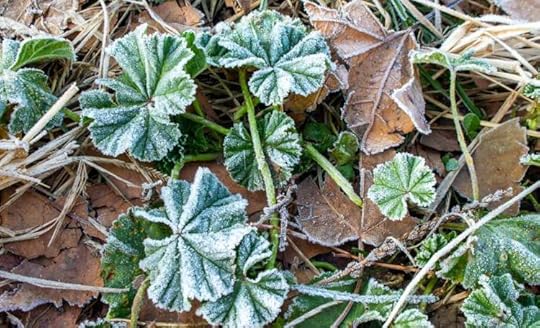 33 mm, 1/50 sec, f/11, ISO 640
33 mm, 1/50 sec, f/11, ISO 640I’ve also had fun taking pictures of the ducks in my park. So happy they don’t fly south for the winter. Some days, they’re the only things I photograph.
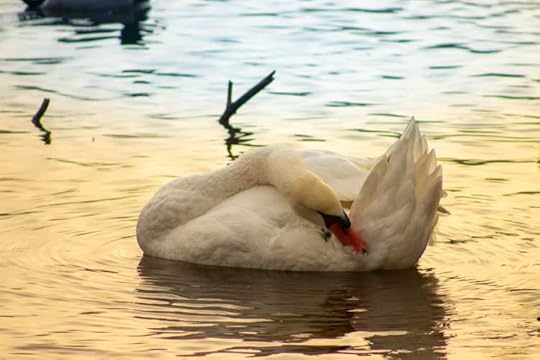 300 mm, 1/1000 sec, f/5.6, ISO 160Look for Shapes
300 mm, 1/1000 sec, f/5.6, ISO 160Look for ShapesTrees may not have pretty colors but, without leaves, we get a lot of nice shapes. And, if you’re photographing at sunrise or sunset, you’ll get pretty colors as well.
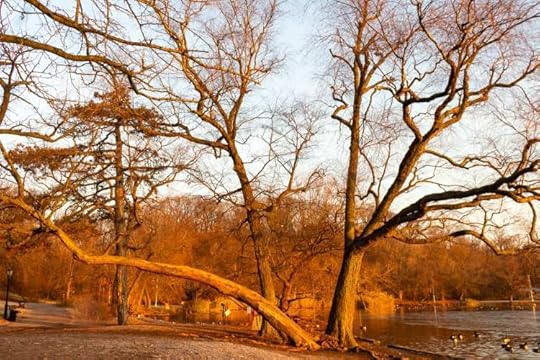 18 mm, 1/30 sec, f/11, ISO 125
18 mm, 1/30 sec, f/11, ISO 125This one has an interesting shape with a cool mirror effect.
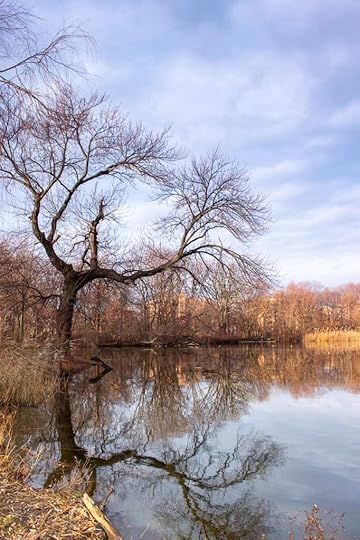 18 mm, 1/30 sec, f/10, ISO 160Look at Reflections
18 mm, 1/30 sec, f/10, ISO 160Look at ReflectionsIf you’re fortunate enough to live near any body of water, take reflection shots. They look good any time of the year.
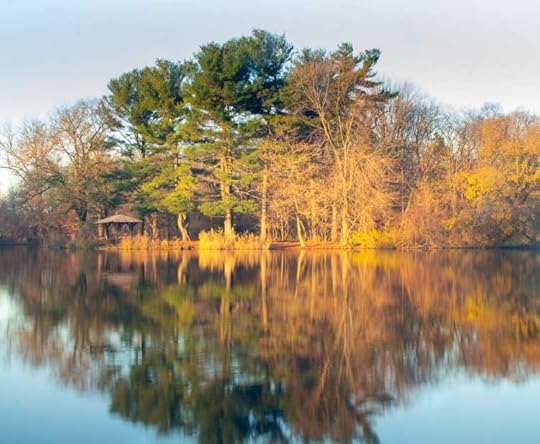 22 mm, 1.6 sec, f/22, ISO 100
22 mm, 1.6 sec, f/22, ISO 100I’ve been using them to practice long exposure shots with my ND filters.
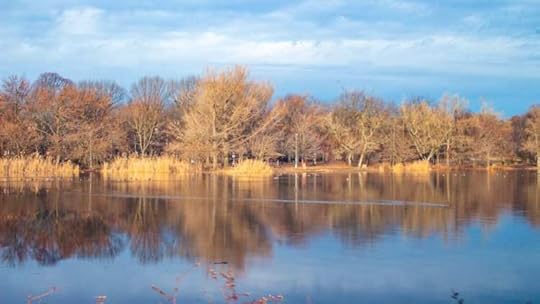 25 mm, 0.5 sec, f/18, ISO 100
25 mm, 0.5 sec, f/18, ISO 100Experiment. This is a good time to try a technique you haven’t mastered. Find your style and have fun.
Follow me on Instagram for more photos.
February 22, 2021
A Guide to Creating Fantasy Plants and Animals

You don’t have to reinvent the wheel when creating your fantasy plants and animals. I gave some inspirational ideas in the post World Building: Creating Fantasy Animals and Creatures. Add a city or town name in front of peppers and you get Fatham sweet pepper found only on the Fatham Isles.
Recently, I’ve been having fun with fluorescent plants. By book 4 of my Merging World series, people rarely see sunlight. This change was gradual, giving nature a chance to adjust. Now, it’s more common to find glowing plants and animals in certain parts of the world.
Don’t limit yourself to what’s realistic. It’s fantasy. Have fun. In The Marked Host, I created dragon deities that can merge with a person either by living in their body or by becoming weapons or jewelry. Doing so, lets the host use their power.
It does help to have an idea of what’s realistic. Do your own research. If you can do so safely, visit your local botanical garden and really study the plants. I got inspiration from my own botanical garden. I talked about that in the post Fantasy World Building: Plants and Their Uses.
BasicsWhat’s the inspiration (are you basing your plants or animals off something that actually exists)?
In you world, what are they called?
Does the name have a special meaning?
If they don’t have a specific name, why?
Where are they located?
Can people find them all over the land or are they exclusive to just one area?
If they’re only found in one area, why?
What’s their physical appearance?
Does the appearance vary? Why?
AnimalsCan you find them in the wild or are they mostly domesticated?
If they’re domesticated, how are they used?
What’s the animals weight? Can it sit on the shoulder or is it large enough to ride?
Where do they live? Ocean? Lake? Mountain? Forest? Underground?
What do they eat?
Can they speak or understand the land’s language?
Are they a rare species or can people find them anywhere?
Are they welcoming to humans or do they attack on sight? Why?
Do people hunt them for sport, food or both?
Are they sacred animals worshiped as deities?
Do they have a story, as in is there a folklore surrounding them?
Do they breed? How? If not, why?
Do they travel in packs or is this animal a loner? If they’re a loner, is there a reason for it?
PlantsDo the plants have magical, medicinal or cosmetic properties?
Where do they grow?
Can they grow anywhere? What kind of environment is best for them?
How big do they get?
Can they move? Do they walk around?
Do they have their own magical properties, such as they can camouflage themselves?
If they’re used for food, which parts are consumed? Roots, stems, leaves, fruits?
If they can be eaten, do they have any positive special effects on the person or animal?
If people can’t consumed them, why? Are they purely decorative?
Are they poisonous? If so, what do they do to people? Does it have the same effect on everyone?
Are they native to your land?
If not, where did they come from?
What do the plants eat? Water? People? A special energy?
Do they regrow when picked/harvested? If they do, how long does it take? If they don’t, why?
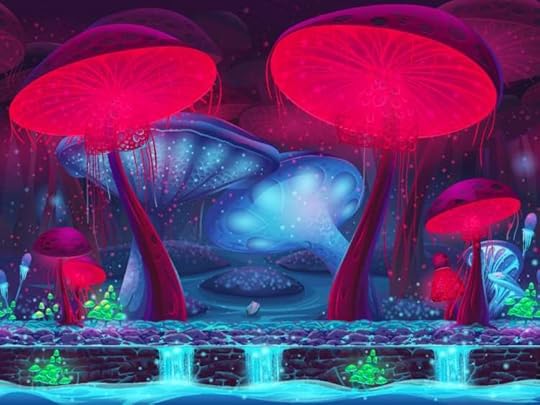
Do you need to create fantasy plants and animals? No. Nothing wrong with regulars cow and horses. Nothing wrong with regular roses and ginger. If you decided to add new plants and animals to your story, only make what you need. Don’t create a magical tree if it’s never mentioned in the story.
Check out my plants and animals Pinterest boards for inspiration.
Do you have any advice to add? Comment below.
More ResourceseBook: The Illustrated Encyclopedia of Herbal Remedies
February 19, 2021
3 Hiking Books For New Day Hikers

I started my “hiking” journal when I discovered The Walk Over the Hudson in Poughkeepsie. To put it mildly, I took a 3-hour train to go on a long walk over a bridge for the pretty view. I wasn’t thinking about hiking books or even the proper gear. Didn’t need it. Then out of nowhere, I wanted to take a trail through the woods. A real forest, not the local park. I explored a simple trail for newbs in Beacon, NY. That started me on my journey to actual hiking.
Then, I had to do my proper homework, especially since I hike solo. I, fortunately, am a super nerd and enjoy homework if I find the subject interesting. Hiking isn’t about just finding a trail and walking until you reach the summit. It can be dangerous, especially if you’re going alone. I plan to hike the Huson Valley mountains in the snow. That’s extra dangerous. I inhaled videos on YouTube. I bought a few guides. Here are 3 hiking books that are helping me along the way.
The Backpacker’s Field ManualThis has been my go-to book. I want to know what kinds of food to eat while hiking. I consult this hiking guide. When NY expected a winter storm, I read this guide to figure out which clothes to wear when photographing the snow.
 Best of the Appalachian Trail: Day Hikes
Best of the Appalachian Trail: Day HikesI don’t plan on doing thru-hikes, at least not solo. I’m not at that level yet. But I can dip my toe into the AT. The book showed me trails I hadn’t known were in NY like Anthony’s Nose. Still haven’t hiked that but it’s on my list.
Best of the Appalachian Trail: Day Hikes"> AMC’s Best Day Hiking in the Catskills & Hudson Valley
AMC’s Best Day Hiking in the Catskills & Hudson ValleyYes, we have Google. We can search the internet for trails. But, I’ve found if you live in a place that has a lot of trails, like NY, your search results always point you to the same day-hiking spots. Usually, they’re the most popular ones. In NY, search results always point to Breakneck Ridge. It probably has beautiful views but it’s also popular which means it’ll be packed all the way to the summit. I hike to get away from people. There’s also the app All Trails. I find it useful but it seems you can only search for trails near a certain areas. I can’t just search for trails in the Hudson Valley. So I bought this:

Because of the rona, I haven’t been able to hike any of the trails in the guide. Obviously, the book’s useless to anyone who’s not in the NY area. AMC’s Best Day Hikes is a series. They probably have a guide for your area.

Plan properly beforehand so you can have fun on your next day hike. Nothing ruins a hike like a preventable injury.
Do you have any books to add? Comment below.



